Top Rankings
North Tonawanda City School District ranks among the top 20% of public school district in New York for:
Category
Attribute
Community Size
Largest student body (number of students) (Top 1%)
For the 2025 school year, there is 1 public middle school serving 478 students in North Tonawanda City School District. This district's average middle testing ranking is 4/10, which is in the bottom 50% of public middle schools in New York.
ÎÛÎÛÂþ» Middle School in North Tonawanda City School District have an average math proficiency score of 32% (versus the New York public middle school average of 40%), and reading proficiency score of 42% (versus the 51% statewide average).
Minority enrollment is 16% of the student body (majority Hispanic), which is less than the New York public middle school average of 63% (majority Hispanic).
Overview
This School District
This State (NY)
# Schools
6 Schools
1,659 Schools
# Students
3,137 Students
890,054 Students
# Teachers
292 Teachers
83,739 Teachers
Student : Teacher Ratio
11:1
11:1
District Rank
North Tonawanda City School District, which is ranked #542 of all 1,015 school districts in New York (based off of combined math and reading proficiency testing data) for the 2021-2022 school year.
The school district's graduation rate of 79% has decreased from 81% over five school years.
Overall District Rank
#555 out of 1020 school districts
(Bottom 50%)
(Bottom 50%)
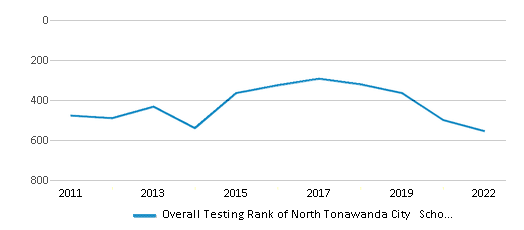
Math Test Scores (% Proficient)
45%
46%
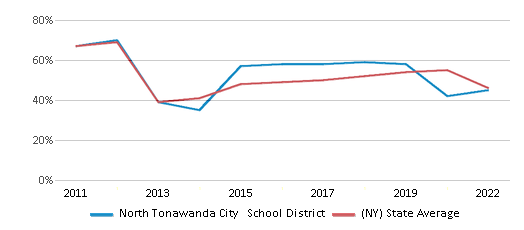
Reading/Language Arts Test Scores (% Proficient)
44%
49%

Science Test Scores (% Proficient)
88%
78%

Graduation Rate
79%
87%
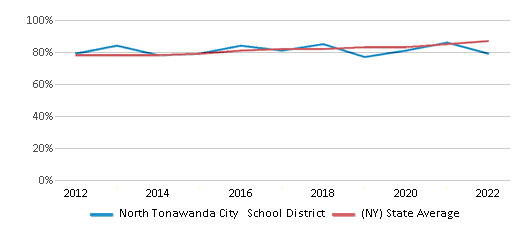
Students by Ethnicity:
Diversity Score
0.29
0.73
# American Indian Students
22 Students
7,222 Students
% American Indian Students
1%
1%
# Asian Students
43 Students
81,213 Students
% Asian Students
1%
9%
# Hispanic Students
198 Students
270,400 Students
% Hispanic Students
6%
30%
# Black Students
85 Students
175,155 Students
% Black Students
3%
20%
# White Students
2,636 Students
325,608 Students
% White Students
84%
37%
# Hawaiian Students
1 Student
2,099 Students
% Hawaiian Students
n/a
n/a
# Two or more races Students
150 Students
28,478 Students
% of Two or more races Students
5%
3%
Students by Grade:
# Students in PK Grade:
-
8,468
# Students in K Grade:
233
26,528
# Students in 1st Grade:
223
28,304
# Students in 2nd Grade:
258
28,365
# Students in 3rd Grade:
231
27,931
# Students in 4th Grade:
244
29,265
# Students in 5th Grade:
251
43,975
# Students in 6th Grade:
242
157,405
# Students in 7th Grade:
246
185,375
# Students in 8th Grade:
232
188,665
# Students in 9th Grade:
232
40,472
# Students in 10th Grade:
250
36,147
# Students in 11th Grade:
238
33,448
# Students in 12th Grade:
244
33,009
# Ungraded Students:
13
22,697
District Revenue and Spending
The revenue/student of $24,887 in this school district is less than the state median of $31,307. The school district revenue/student has stayed relatively flat over four school years.
The school district's spending/student of $24,787 is less than the state median of $32,183. The school district spending/student has stayed relatively flat over four school years.
Total Revenue
$78 MM
$78,541 MM
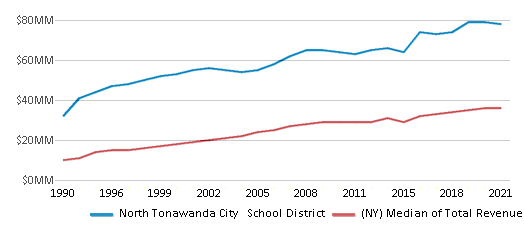
Spending
$78 MM
$80,737 MM

Revenue / Student
$24,887
$31,307

Spending / Student
$24,787
$32,183
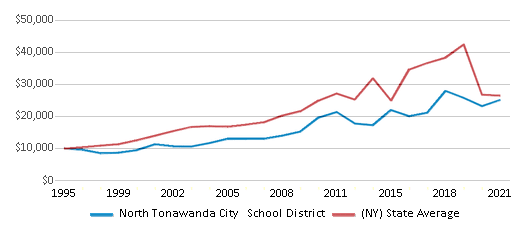
Best North Tonawanda City School District ÎÛÎÛÂþ» Middle Schools (2025)
School
(Math and Reading Proficiency)
(Math and Reading Proficiency)
Location
Grades
Students
Rank: #11.
North Tonawanda Middle School
(Math: 30-34% | Reading: 40-44%)
Rank:
Rank:
4/
Bottom 50%10
455 Meadow Dr
North Tonawanda, NY 14120
(716) 807-3700
North Tonawanda, NY 14120
(716) 807-3700
Grades: 7-8
| 478 students
Recent Articles

Year-Round Or Traditional Schedule?
Which is more appropriate for your child? A year-round attendance schedule or traditional schedule? We look at the pros and cons.

Why You Should Encourage Your Child to Join a Sports Team
Participating in team sports has a great many benefits for children, there is no doubt. In this article you will learn what those benefits are.

White Students are Now the Minority in U.S. ÎÛÎÛÂþ» Schools
Increasing birth rates among immigrant families from Asia and Central and South America, combined with lower birth rates among white families, means that for the first time in history, public school students in the United States are majority-minority. This shift in demographics poses difficulties for schools as they work to accommodate children of varying language abilities and socio-economic backgrounds.





